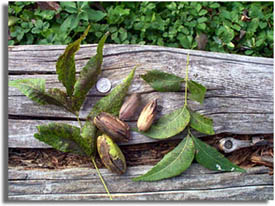| April 2006
 Pecan trees are sometimes
infested by dot-size insects called pecan phylloxera in April. The
feeding of these minuscule insects can produce round galls ¼- to
1-inch in diameter on twigs and leaves in late April, May and early
June. Pecan trees are sometimes
infested by dot-size insects called pecan phylloxera in April. The
feeding of these minuscule insects can produce round galls ¼- to
1-inch in diameter on twigs and leaves in late April, May and early
June.
The galls generally split open in late May and early June and release
small, greenish, winged aphid-like phylloxera. The galls then dry,
which causes leaf drop and twig dieback.
Severe infestations of this insect can cause loss of the pecan crop
for the current year and also for the following year, according to
LSU AgCenter pecan expert Dr. John Pyzner.
No effective control of phylloxera is available once the galls are
present. Sprayed insecticides will not reach the insects inside the
galls, and systemic insecticides will usually not reach high enough
concentrations in the galls to kill the insects.
Spraying for phylloxera after the galls split open will kill some of
the insects. Pyzner cautions, however, that control at gall split is
not very effective because of the extended period over which the
galls release insects.
"Spraying at gall split will not reduce any current injury to the
tree, since phylloxera only causes damage during April when they
start feeding on the new shoot growth," Pyzner says.
Phylloxera can damage tree appearance and reduce tree vigor; however,
they rarely kill a tree, unless the tree has other major problems.
The most effective control of pecan phylloxera is in the spring when
the eggs hatch and the small insects crawl to the buds. Young
phylloxera resemble very small, yellowish-orange aphids with
dark-gray legs when they appear in the spring about the time the buds
unfold.
A 10X or higher hand lens or magnifying glass is needed to see the
phylloxera. The young insect inserts its beak into the new growth and
injects a toxin. This injection causes abnormal tissue growth, which
forms a gall around the insect. Phylloxera must be controlled before
the galls enclose the insect.
An insecticide application is usually effective in controlling
phylloxera when approximately ½- to ¾- inch of new bud growth occurs.
This bud stage normally occurs around April 8, but weather
conditions, varieties and locations can alter this date.
A second insecticide application may be needed for severe
infestations. Pyzner recommends insecticides such as Provado 1.6F at
4 to 7 ounces per acre, Lorsban 4E at 1.5 to 2 pints per acre and
Warrior at 3 to 5 ounces an acre for phylloxera control. Treat only
those trees previously infested and those adjacent to them.
Phylloxera are delicate insects and usually do not spread very far;
therefore, good control one year will often keep phylloxera damage
low for several years unless infested trees are near.
For related horticulture topics, look for Gardening and Get It
Growing links in the Feature section of the LSU AgCenter Web site:
www.lsuagcenter.com.
|